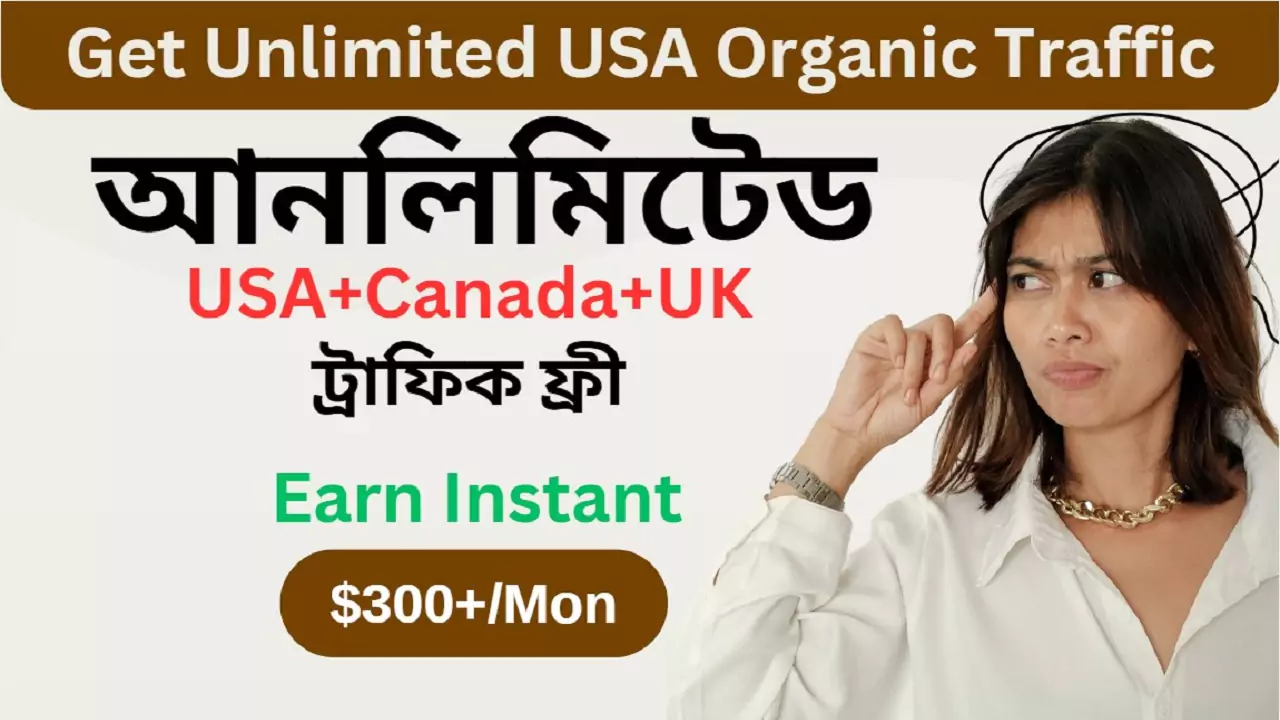
Organic traffic is the lifeblood of any successful website. Unlike paid ads, organic traffic brings visitors to your site without ongoing costs, offering a sustainable way to grow your audience and business. But how can you generate unlimited organic traffic for free? It sounds almost too good to be true, but with the right strategies and consistent effort, it’s achievable.
In this article, we’ll explore actionable steps that can help you harness the power of organic traffic and lead to continuous growth over time. From optimizing your content for search engines to leveraging social media, these strategies will lay the groundwork for a traffic surge.
UNLIMITED ORGANIC TRAFFIC FREE FOR YOUR WEBSITE: STRATEGIES FOR SUCCESS
1. Understanding Organic Traffic
Organic traffic refers to visitors who land on your website through unpaid search results on search engines like Google, Bing, and Yahoo. These users are actively searching for information, products, or services that match your site’s offerings. As a result, they tend to be more engaged and convert at a higher rate compared to paid traffic.
Organic traffic is valuable because it’s:
- Sustainable: Once established, organic traffic keeps coming as long as your content remains relevant and optimized.
- Cost-effective: You don’t need to spend money on ads or promotions.
- Highly targeted: Visitors find your site because it answers their query or provides something they need.
But generating organic traffic isn’t as simple as posting a blog and hoping for the best. It requires ongoing optimization, quality content creation, and a strategic approach to SEO (Search Engine Optimization).
2. Mastering On-Page SEO
To generate unlimited organic traffic for free, mastering on-page SEO is a must. On-page SEO involves optimizing individual web pages to rank higher on search engine results pages (SERPs). Here’s how you can do it effectively:
a) Optimize Title Tags
Your title tag is one of the most critical ranking factors. Ensure your title contains your primary keyword and is no longer than 60 characters. Titles that are descriptive and compelling encourage higher click-through rates.
b) Use Meta Descriptions
A well-written meta description can improve your page’s click-through rate (CTR) from the search results. Include your main keyword, and ensure that your meta descriptions are between 150-160 characters.
c) Header Tags (H1, H2, H3)
Using header tags helps search engines understand the structure of your content. The H1 tag should contain your primary keyword and should only be used once per page. H2 and H3 tags should break up content into sections, making it easier for users and search engines to navigate.
d) Keyword Optimization
While you should naturally include your primary and secondary keywords throughout your content, avoid keyword stuffing. Google’s algorithms are smart enough to detect this and may penalize your site. Aim for semantic SEO, where you naturally incorporate relevant keywords and phrases that users might search for.
e) Internal Linking
Internal linking between related articles or pages on your site helps search engines crawl your website and discover new content. It also increases time spent on your site by providing users with more relevant content to explore.
3. Content is King: Creating Valuable Content
When it comes to organic traffic, content is still king. The best way to attract free, organic traffic is by consistently creating high-quality, valuable content that your audience loves. Here are ways to maximize your content strategy:
a) Focus on Evergreen Content
Evergreen content remains relevant and valuable over time. Articles like “How to Lose Weight” or “SEO Strategies for 2024” will remain useful for years, unlike news or trends that quickly become outdated.
b) Write In-depth Content
Google rewards comprehensive content that answers a user’s query in detail. Long-form content (1500-2000 words) often ranks higher because it provides more value. But be sure that your content remains concise, well-structured, and easy to read.
c) Regularly Update Old Content
Even evergreen content needs occasional updates. If you have older blog posts that rank well, check them periodically to add new information, refresh outdated sections, and ensure all links work correctly.
d) Create Visual Content
Visual content like infographics, videos, and images can enhance your blog posts, making them more engaging. Posts with images tend to attract more traffic and shares than those without.
e) Use Content Clusters
Content clusters are a powerful way to organize your content around a core topic. For example, if your core topic is “SEO,” you could write a comprehensive guide on SEO and then create smaller, in-depth posts on subtopics like “on-page SEO,” “backlinking strategies,” and “keyword research.”
4. Backlinking for Free Organic Traffic
Backlinks—links from other websites pointing to your own—are one of the most important ranking factors. The more quality backlinks your site has, the more authority it will have in the eyes of search engines. Here are some free ways to build backlinks:
a) Guest Blogging
Reach out to websites in your niche and offer to write a guest post. In return, you can include a link back to your site. Be sure to provide value with your guest posts and avoid spammy links.
b) HARO (Help A Reporter Out)
HARO connects journalists with sources. By signing up for HARO, you can offer expert insights to journalists and get quoted in their articles, which often includes a backlink to your site.
c) Broken Link Building
This strategy involves finding broken links on other websites and offering your content as a replacement. This not only helps the website owner but also earns you a valuable backlink.
d) Infographic Promotion
Infographics are highly shareable. By creating high-quality infographics and sharing them with bloggers or website owners, you can attract backlinks. Infographics are more likely to be cited in other articles, which means more links for your site.
5. Leveraging Social Media for Organic Traffic
While social media itself may not directly boost your organic search rankings, it’s an excellent way to amplify your content and drive more traffic. Here’s how to use social media effectively for generating organic traffic:
a) Share Content Regularly
Share your blog posts, infographics, videos, and other content across social media platforms like Facebook, Twitter, Instagram, and LinkedIn. Be consistent and provide value to your followers.
b) Engage with Followers
Engagement is key to growing your social presence. Respond to comments, participate in discussions, and show appreciation for those who share your content.
c) Use Hashtags
Hashtags can increase the reach of your content, especially on platforms like Instagram and Twitter. Use relevant hashtags to make your content discoverable to a larger audience.
d) Join Social Media Groups
On Facebook, LinkedIn, and Reddit, you can find niche-specific groups where your target audience hangs out. Share your insights and content in these communities to drive more traffic to your site.
6. Utilize Email Marketing
One often overlooked method for driving organic traffic is email marketing. By building an email list and sending regular newsletters with valuable content, you can drive repeat visitors to your site.
a) Build Your Email List
Use opt-in forms, pop-ups, and lead magnets (such as free eBooks or checklists) to encourage visitors to subscribe to your email list. This allows you to engage with them over time and bring them back to your site.
b) Send Regular Emails
Once you have an email list, send regular newsletters containing helpful content, exclusive offers, or the latest blog posts. Be sure not to overwhelm your subscribers with too many emails, but stay consistent enough to keep them engaged.
7. The Power of Analytics
You can’t improve what you don’t measure. Google Analytics and Google Search Console are invaluable tools for monitoring your organic traffic and refining your strategy.
a) Track Your Keywords
Using Google Analytics, you can track which keywords are bringing traffic to your site. This helps you identify new content opportunities and understand which topics are most popular with your audience.
b) Monitor Page Performance
Identify which pages are receiving the most traffic and analyze why. Is it due to keyword optimization, backlinks, or high engagement? Use this information to replicate successful strategies on other pages.
c) Find Traffic Sources
Google Analytics shows you where your traffic is coming from—whether it’s search engines, social media, direct, or referral traffic. This data helps you focus your efforts on the most effective channels.
8. Patience and Persistence: The Key to Organic Traffic
Generating unlimited organic traffic for free is not an overnight process. It takes time, effort, and persistence. However, with consistent SEO, high-quality content creation, and a focus on building valuable relationships in your niche, your traffic will increase over time.
Remember that organic traffic is about long-term growth. The more effort you put into creating value and optimizing your site for search engines, the more traffic you will attract—and it will be traffic that is genuinely interested in what you have to offer.
By following these strategies, you can create a website that consistently attracts unlimited organic traffic for free. Whether you’re just starting or looking to take your website to the next level, these techniques provide a strong foundation for long-term success. Keep optimizing, keep creating, and watch your organic traffic grow exponentially!
Read More:
>> Top 10 Healthy Foods to Gain Weight 2024
>> T20 World Cup Live
>> Adsterra থেকে মাসে লক্ষ টাকা আয় করার উপায়
>> ঘরে বসে প্যাসিভ ইনকাম করুন ১০টি উপায়ে
Our Social Media List
Thanks for reading this post and Follow my Facebook Page.




